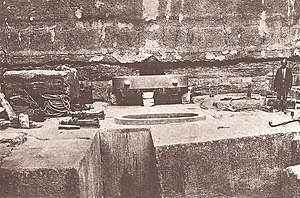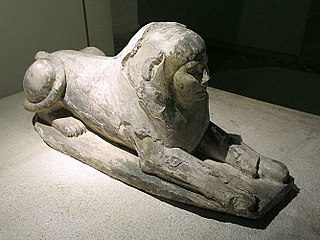
Saqqara, also spelled Sakkara or Saccara in English, is a vast, ancient burial ground in Egypt, serving as the necropolis for the Ancient Egyptian capital, Memphis. Saqqara features numerous pyramids, including the world-famous Step pyramid of Djoser, sometimes referred to as the Step Tomb due to its rectangular base, as well as a number of mastabas. Located some 30 km (19 mi) south of modern-day Cairo, Saqqara covers an area of around 7 by 1.5 km.

The Egyptian pyramids are ancient pyramid-shaped masonry structures located in Egypt. As of November 2008, sources cite either 118 or 138 as the number of identified Egyptian pyramids. Most were built as tombs for the country's pharaohs and their consorts during the Old and Middle Kingdom periods.
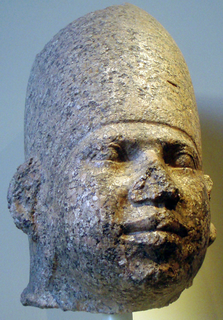
Huni was an ancient Egyptian king and the last pharaoh of the 3rd dynasty during the Old Kingdom period. Following the Turin king list, he is commonly credited with a reign of 24 years, ending c. 2600 BC.
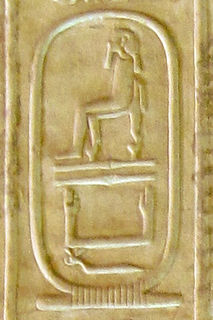
Shepseskaf was the sixth and last pharaoh of the Fourth Dynasty of Egypt during the Old Kingdom. He reigned 6 to 8 years starting circa 2510 BC. The only activities firmly datable to his reign are the completion of the temple complex of the Pyramid of Menkaure and the construction of its own mastaba tomb at South Saqqara, the Mastabat al-Fir’aun, "stone bench of the pharaoh".

George Andrew Reisner was an American archaeologist of Ancient Egypt, Nubia and Palestine.

The Layer Pyramid is a ruined step pyramid dating to the 3rd Dynasty of Egypt and located in the necropolis of Zawyet El Aryan. Its ownership is uncertain and may be attributable to pharaoh Khaba. The pyramid architecture, however, is very similar to that of the Buried Pyramid of king Sekhemkhet and for this reason is firmly datable to the 3rd Dynasty.
Minkhaf I was an ancient Egyptian prince of the 4th Dynasty. Minkhaf was a son of Pharaoh Khufu, half-brother of Pharaoh Djedefre and elder brother of Pharaoh Khafra. His mother may have been Queen Henutsen. Minkhaf had a wife and at least one son, but their names are not known.
Meritites I was an ancient Egyptian queen of the 4th dynasty. Her name means "Beloved of her Father". Several of her titles are known from a stela found at Giza. She was buried in the middle Queen’s Pyramid in Giza.
Kaemsekhem was an Ancient Egyptian nobleman and probably the son of Crown Prince Kawab and Hetepheres II. He later served as the director of the royal palace. He was buried in mastaba G 7660 in the east field, which is part of the Giza Necropolis.
Meritites II or Meritites A was a 4th dynasty Princess of Ancient Egypt, and probably a daughter of King Khufu. She may have been a daughter of Meritites I based on the fact that this queen is mentioned in mastaba G 7650. She married the Director of the Palace Akhethotep and she had several children with her husband. Meritites and her husband shared a mastaba in Giza.
Nefertkau II was an Ancient Egyptian noble lady, the wife of Prince Khufukhaf I, son of pharaoh Khufu.
Nefertkau III was an Ancient Egyptian princess. She lived during the 4th dynasty. She was possibly a daughter of Meresankh II and Horbaef. If so, she was a granddaughter of King Khufu. Baud has proposed that Nefertkau was a daughter of Khufu instead. Nefertkau has the titles King's daughter of his body and Priestess of Neith in a scene in the chapel of her tomb. She was married to an official named Iynefer. Nefertkau and Iynefer had a daughter also called Nefertkau and two or three sons. Strudwick has suggested that Iynefer may be a son of Khufu. Depending on the interpretation of the family relationships Nefertkau may have married either her uncle or her brother.

The East Field is located to the east of Khufu's pyramid and contains cemetery G 7000. This cemetery was a burial place for some of the family members of Khufu. The cemetery also includes mastabas from tenants and priests of the pyramids dated to the 5th dynasty and 6th dynasty.

Cemetery GIS is a necropolis in the Giza Plateau. It derives its name from its proximity to pyramid G I (Khufu). The tombs are located on the south side of that pyramid and hence the name G I South Cemetery. Reisner thought the cemetery a continuation of the G7000 cemetery which is part of the Giza East Field. The construction postdates that of mastaba G 7070 of Sneferukhaf. Junker dated the cemetery to the reign of Menkaure based on the presence of granite powder thought to derive from the dressing of the second pyramid at Giza. Reisner allows for a possible construction date dating to the reign of Khafre.

G1-c is one of the subsidiary pyramids of the Giza East Field of the Giza Necropolis immediately to the eastern side of the Great Pyramid of Giza, built during the Fourth dynasty of Egypt. It is the southern of the three pyramids of the queens and is the one of Queen Henutsen. It is 46.25 metres wide and had a height of 29.60 metres. A niche, four inches deep was dug in the south wall of the burial chamber. Pyramid G 1c was originally not a part of Khufu's pyramid complex, as its southern side is aligned not with the side of the Great Pyramid, but with Khufukhaf I's mastaba tomb nearby. Pyramid G 1c was at some point thought to possibly be a satellite pyramid, because it did not come with a boat pit like pyramids G 1a and G 1b. It was later determined to be an unfinished pyramid however which was constructed in a hurry. Henutsen is thought to have been buried in the tomb. Dr. Rainer Stadelmann believes Khufukhaf is the same person as Khafra and the pyramid was built by him for his mother, but this identification is doubtful.

Bikheris is the Hellenized name of an Ancient Egyptian pharaoh, who may have ruled during the 4th Dynasty around 2570 BC. Next to nothing is known about this ruler and some Egyptologists even believe him to be fictitious.
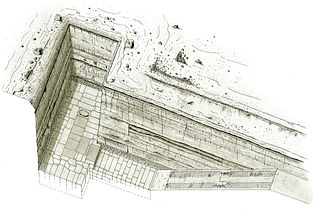
The Unfinished Northern Pyramid of Zawyet El Aryan, also known as Pyramid of Baka and Pyramid of Bikheris is the term Archaeologists and Egyptologists use to describe a large shaft part of an unfinished pyramid at Zawyet El Aryan in Egypt. It is dated by mainstream scholars to the early or the mid-4th Dynasty during the Old Kingdom period. The pyramid owner is not known for certain and most egyptologists, such as Miroslav Verner, think it should be a king known under his hellenized name, Bikheris, perhaps from the Egyptian Baka. On the contrary, Wolfgang Helck and other egyptologists doubt this attribution.

Setka is the name of an ancient Egyptian crown prince. He is known for his statuette in the shape of a seated scribe. He is also subject of a theory that claims he was pharaoh of Egypt for a very short time.
Baka is the name of an ancient Egyptian prince. He is known for his destroyed statuette. He is also subject of a theory that claims he was pharaoh of Egypt for a very short time. Thus, he might be identical to a scarcely known king named Bikheris.
